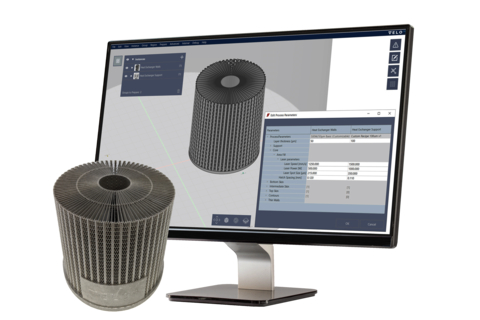Velo3D Unlocks Freedom in Metal 3D Printing With Flow Developer
- None.
- None.
From Black Box to Full Transparency and Control, New Product Enables a Pathway to Migrate Additive Manufacturing Knowledge to Velo3D’s Fully Integrated Solution and Print Process Optimization

A computer screen showing a user creating parameter sets for a heat exchanger with Flow Developer. Developer enables users to transfer or create parameter sets that optimize the process for their specific application. (Photo: Business Wire)
Developer is available for users of Flow 7.0, the latest version of Velo3D’s print preparation software that seamlessly turns traditional design files into print files. Developer grants editor-level access to print parameters, giving companies maximum flexibility and control when working with their Velo3D additive manufacturing solution. With this access, users can import proven parameters they have developed, optimize default parameters for specific application needs, and develop parameter sets supporting new material development for novel solutions and specific applications. Once a part that was produced using Developer has been qualified, users can scale production leveraging the control, quality, and repeatability of Velo3D’s additive manufacturing solution.
“It can be a challenge to produce repeatable results across different metal 3D printers—even when they’re the same model of printer—however, Velo3D’s solution can consistently produce parts within spec across any of its printers, which provides huge benefits for companies looking to scale production of their parts,” said Additive Manufacturing Manager at Ursa Major, Thomas Pomorski. “When our team first tested Flow Developer, we transferred parameters we developed on a non-Velo system, hoping we could easily produce the same part on Velo3D’s system and then take advantage of the scalability it provides. On our first try, we imported a part with highly complex, sensitive features and achieved incredible results that were within specification. Since then, we’ve accomplished the same process with other parts and in some cases, have been able to reduce print time by nearly
Prior to its general release, Developer has been made available to select customers for feedback, including Ursa Major, a privately funded company developing rocket propulsion technology. During this phase, engineers have been able to directly transfer their custom parameters into their Velo3D solutions with exceptional results. Developer gave early-access customers the ability to easily scale production of their parts as their applications matured from development to production.
“Velo3D’s mission has always been to provide an additive manufacturing solution that delivers repeatability from machine-to-machine, which is still a big shortcoming with legacy metal 3D printers,” said Brad Kreger, CEO of Velo3D. “Previously, we did this by providing pre-defined parameters within the system, which left customers wanting to know what’s inside our ‘black box’ and looking for more flexibility. When you combine Flow Developer with our ability to produce identical parts using the same print file, we strike the perfect balance between usability, repeatability, and flexibility. This has allowed these early access customers to think outside the box of conventional additive manufacturing to progress beyond their current limitations and realize true production scalability for their parts.”
Flow is a key part of Velo3D’s unique approach to additive manufacturing, which differs from competitors’ offerings by providing a fully integrated solution that includes hardware and software, which come together to ensure machine-to-machine consistency. In addition to Flow and the Sapphire family of printers, the company’s solution also includes Assure quality assurance software, which monitors a print layer-by-layer to ensure consistent geometric accuracy, surface finish, and material properties throughout a finished part.
Resources:
-
Book a demo of Developer at Additive Manufacturing Users Group (AMUG) 2024, which takes place in
Chicago on March 10-14, 2024. - Visit the Flow Developer page on the Velo3D website to download the product brief or learn more about the product.
- Learn more about Flow print preparation software and other portions of Velo3D’s fully integrated solution.
About Velo3D:
Velo3D is a metal 3D printing technology company. 3D printing—also known as additive manufacturing (AM)—has a unique ability to improve the way high-value metal parts are built. However, legacy metal AM has been greatly limited in its capabilities since its invention almost 30 years ago. This has prevented the technology from being used to create the most valuable and impactful parts, restricting its use to specific niches where the limitations were acceptable.
Velo3D has overcome these limitations so engineers can design and print the parts they want. The company’s solution unlocks a wide breadth of design freedom and enables customers in space exploration, aviation, power generation, energy, and semiconductor to innovate the future in their respective industries. Using Velo3D, these customers can now build mission-critical metal parts that were previously impossible to manufacture. The fully integrated solution includes the Flow print preparation software, the Sapphire family of printers, and the Assure quality control system—all of which are powered by Velo3D’s Intelligent Fusion manufacturing process. The company delivered its first Sapphire system in 2018 and has been a strategic partner to innovators such as SpaceX, Aerojet Rocketdyne, Lockheed Martin, Avio, and General Motors. Velo3D has been named as one of Fast Company’s Most Innovative Companies for 2023. For more information, please visit Velo3D.com, or follow the company on LinkedIn or Twitter.
Velo, Velo3D, Sapphire and Intelligent Fusion are registered trademarks of Velo3D, Inc. Without Compromise, Flow, and Assure are trademarks of Velo3D, Inc.
All Rights Reserved © Velo3D, Inc.
Forward-Looking Statements:
This press release includes “forward-looking statements” within the meaning of the “safe harbor” provisions of the Private Securities Litigation Reform Act of 1996. The company’s actual results may differ from its expectations, estimates and projections and consequently, you should not rely on these forward-looking statements as predictions of future events. Words such as “expect”, “estimate”, “project”, “budget”, “forecast”, “anticipate”, “intend”, “plan”, “may”, “will”, “could”, “should”, “believes”, “predicts”, “potential”, “continue”, and similar expressions are intended to identify such forward-looking statements. These forward-looking statements include, without limitation, statements regarding the company’s bookings which may not lead to completed sales, anticipated reductions in the company’s operational expenses, the company’s expectations regarding its ability to be cash flow positive by the second half of 2024, and the company’s other expectations, hopes, beliefs, intentions or strategies for the future. These forward-looking statements involve significant risks and uncertainties that could cause the actual results to differ materially from the expected results. You should carefully consider the risks and uncertainties described in the “Risk Factors” section of the company’s Annual Report on Form 10-K for the fiscal year ended December 31, 2022 (the “FY 2022 10-K”), which was filed by the company with the SEC on March 20, 2023 and the other documents filed by the company from time to time with the SEC. These filings identify and address other important risks and uncertainties that could cause actual events and results to differ materially from those contained in the forward-looking statements. Most of these factors are outside the company’s control and are difficult to predict. Factors that may cause such differences include, but are not limited to: (1) the inability of the company to execute its business plan, which may be affected by, among other things, competition, the ability of the company to grow and manage growth profitably, maintain relationships with customers and suppliers and retain its key employees; (2) the period over which the company anticipates its existing cash and cash equivalents will be sufficient to fund its operating expenses and capital expenditure requirements and the company's ability to continue as a going concern; (3) the company's ability to service and comply with its indebtedness; (4) the company's ability to satisfy New York Stock Exchange Listing rules; (5) changes in the applicable laws or regulations; (6) the possibility that the company may be adversely affected by other economic, business, and/or competitive factors; (7) the lingering effects of the global COVID-19 pandemic; and (8) other risks and uncertainties indicated from time to time described in the FY 2022 10-K, including those under “Risk Factors” therein, and in the company’s other filings with the SEC. The company cautions that the foregoing list of factors is not exclusive and not to place undue reliance upon any forward-looking statements, including projections, which speak only as of the date made. The company does not undertake or accept any obligation to release publicly any updates or revisions to any forward-looking statements to reflect any change in its expectations or any change in events, conditions or circumstances on which any such statement is based.
View source version on businesswire.com: https://www.businesswire.com/news/home/20240228041656/en/
Investor Relations:
Velo3D
Bob Okunski, VP Investor Relations
investors@velo3d.com
Media Contact:
Velo3D
Dan Sorensen, Senior Director of PR
press@velo3d.com
Source: Velo3D, Inc.







